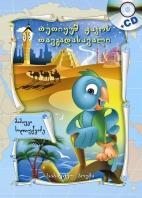JACQUOT THE PARROT
SALUKVADZE MAMUKA
Mamuka Salukvadze’s Jacquot the Parrot’s Adventure is a conceptual project, devised to fit the genre of children’s literature, which was meant to discuss the historic cataclysms of the 20th century. Mamuka Salukvadze was born in 1955, which is why the patterns of this text were absolutely fitting for him: a description of each year from 1900 to 2000, following the ups and downs in the life of his invented character, the parrot Jacquot. In any case, at the age of 45 he had managed to complete this project, once he had reached the present, and then would have followed on page by page, if only, while working with more and more haste, fate and his health would have allowed him to do so. But unfortunately, things turned out otherwise and he died before the 20th century was over, so that he left us with only 26 chapters, and described the epoch only up to 1925. Each year the parrot Jacquot finds himself in various countries, and each chapter deals with important events and prominent personalities encountered in one particular year and country. Mamuka Salukvadze often tries to choose an aspect in which the most important historical or cultural events occur. Although we cannot say that he is very direct in seeking a mainstream course of action or, on the other hand, we cannot deny that the regime, under which this text was composed, has left a definite mark on this book. As the author says in the chapter ‘Birth’, Jacquot is a species of parrot that inhabits southern Africa and these parrots are endowed with an amazing talent for perception and memorisation, imagination and eloquence. Our Jacquot, too, is born in Africa and travels his continent first, then Europe, America and Australia… At one point he observes the revolution happening in Russia, and at another the cultural events in Paris; sometimes, though, he finds himself among the Amerindians and masters the Mayan language. The book is written in 10-syllable stanzas, with the caesura half-way through the line, and rhymed abcb. It is relaxed, joyful and will attract not only children and young persons, but good readers who are older.
‘I can imagine a poet in some European country writing this poem, and it being turned into a film script very rapidly, and how the whole structure of an informative and entertaining serial would emerge in a cartoon, how much could be done to ensure that children of many countries could enjoy this very beautiful work.’
Maka Jokhadze, prose writer, critic
In case of using the information, please, indicate the source.
